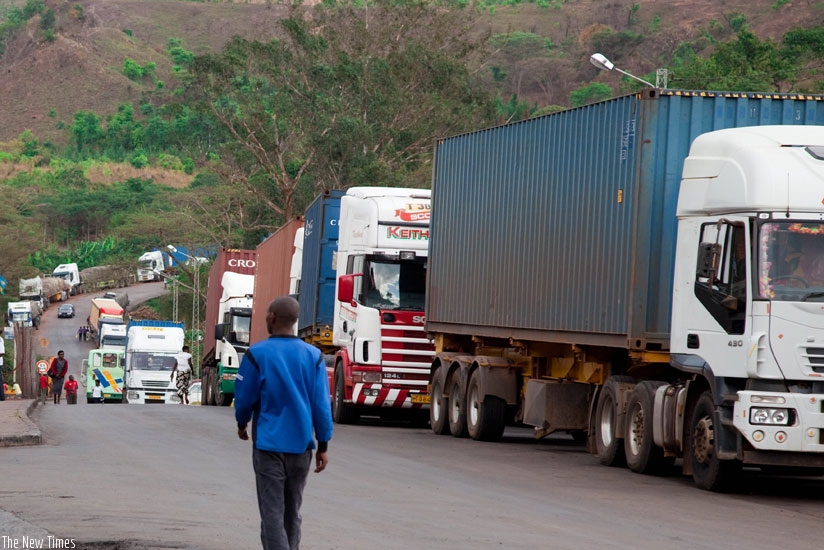Technical experts from Rwanda, Uganda, Kenya, Burundi, DR Congo and South Sudan on Friday concluded a five-day meeting in Kigali with a list of recommendations which, if implemented, will guarantee enhanced trade and transport logistics along the Northern Corridor.


Technical experts from Rwanda, Uganda, Kenya, Burundi, DR Congo and South Sudan on Friday concluded a five-day meeting in Kigali with a list of recommendations which, if implemented, will guarantee enhanced trade and transport logistics along the Northern Corridor.
Among the recommendations is the call on the six member states "to implement high speed weigh-in-motion weighbridges to minimise delays at weighbridge stations.”
Weigh-in-motion or weighing in motion (WIM) devices are designed to capture and record axle weights and gross vehicle weights as vehicles drive over a measurement site, without necessarily having to stop, which increases efficiency.
Rwanda has started a process of acquiring such weigh in motion weighbridges whose applications include determining axle weights and gross weight of vehicles as well as accurate weighing at low and high vehicle speeds.
Today, such scales are only in use in Kenya.
Across the corridor, the approved standard axle load limit is 56 tons of gross weight for all freight trucks.Peterson Mutabazi, the Transport Division Manager at the Ministry of Infrastructure (Mininfra), said axle load control was a protection to the country’s infrastructure.
"Axle load should be embraced by not only the international truckers but local or national freight transporters as well. It should be a culture for all Rwandans to protect and safeguard the infrastructure instead of waiting for penalties,” he said.
The meeting in addition recommended that member states should harmonise the implementation of the vehicle load controls by applying the latter uniformly across the region.
The meeting was the ninth technical committee on customs and trade facilitation and the seventh technical committee on transport policy and planning.
It brought together delegates from public and private sectors in the Northern Corridor member states as well as Regional Economic Communities.
The Northern Corridor is the transport corridor linking the land locked countries of Uganda, Rwanda and Burundi with Kenya’s maritime port of Mombasa.
Its infrastructure connects all the five countries of the East African Community (EAC) and beyond since the Northern Corridor also serves eastern DR Congo, South Sudan and northern Tanzania.
Alex Kanyama Zulu, Director of Trade Facilitation and Policy Harmonisation at the Intergovernmental Standing Committee on Shipping (ISCOS), a four-member group (Kenya, Tanzania, Uganda and Zambia) serving as a one stop centre for regional maritime matters and total logistics, said the recommendations will "go a long way” in improving the movement of goods and services from the port of Mombasa to the land-locked countries.
"Africa is competing for foreign direct investment with other regions of the world and therefore, the region has to be attractive in terms of ensuring that there is transparency and predictability in the supply chains in order to reduce the cost of doing business,” he said.
"It is gratifying to note that efforts are being made in the Northern Corridor in order to make it an economic corridor. The future looks bright for the region”.
The Kigali session, officials said, was of utmost importance in the implementation of the Northern Corridor Transit and Transport Agreement (NCTTCA); a pact initially signed in 1985 between Burundi, Kenya, Rwanda and Uganda as they moved to promote an efficient, cost-effective and reliable transit transport system.
In 1987, the DR Congo became the fifth member after acceding to the accord whose objectives include ensuring freedom of transit among the member states; and safeguarding right to access to or from the sea for landlocked countries.
More about the NCTTCA
A revised NCTTA was signed in Nairobi, Kenya, in October 2007, between Burundi, DR Congo, Kenya, Rwanda, and Uganda, and entered into force in December 2012.
South Sudan acceded to the Agreement as the sixth member state in March 2013.
Since 2007, transit time between Mombasa and Bujumbura has been reduced by half, from over 30 days to about 15 days, as a result of transit facilitation measures undertaken. Some unnecessary border formalities along the Corridor were also removed.
In 2007, the states agreed on the protocols related to maritime port facilities, routes and facilities, customs control, documentation and procedures, transport of goods by rail, transport of goods by road, inland waterways transport, transport by pipeline, multi-modal transport of goods, handling of dangerous goods and measures of facilitation for transit agencies, trade and employees.
The agreement monitors the performance of the corridor on weekly, monthly and annual basis.


